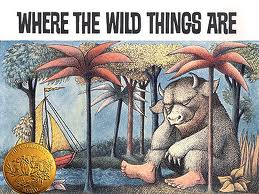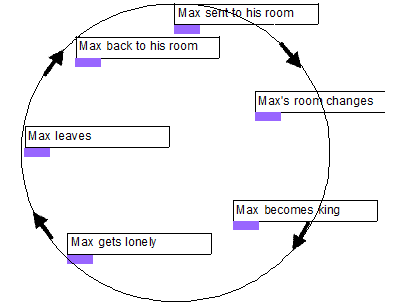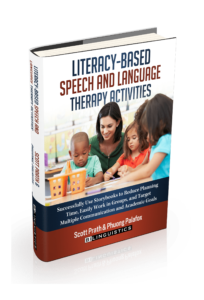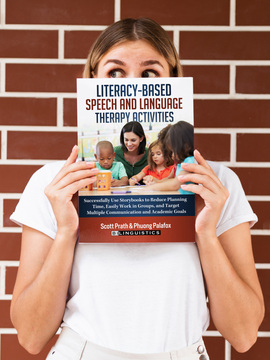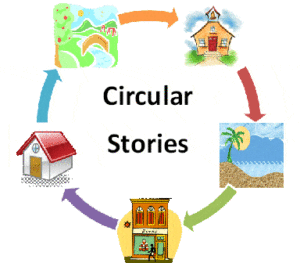 We are excited to continue on this literacy journey with y’all! To follow up on last week’s post, we are going to have a series of blog posts about the different types of Predictable Books. We are starting this week with Chain/Circular Stories.
We are excited to continue on this literacy journey with y’all! To follow up on last week’s post, we are going to have a series of blog posts about the different types of Predictable Books. We are starting this week with Chain/Circular Stories.
A Circular or Chain Story is a story that begins and ends in the same place, such as Where the Wild Things Are or If You Give a Mouse a Cookie.
Circular or chain stories are great for therapy because:
- Many have a great macrostructure of beginning, middle, and end, which helps us teach sequencing.
- They contain the “typical” macrostructure elements such as characters, setting [time and place], problem, solution, initiating event, character intentions and desires, and moral.
- The end of the story comes around full circle, which gives a great opportunity to work on story organization/structure, and making predictions on how a story may end.
- Many have some sort of cause and effect or problem and solution that can be discussed.
- They can be adapted across age/grade levels to work at the cognitive level of the student(s).
How to use Circular or Chain Stories in Speech Therapy
Here is one of our favorite Circular or Chain stories and examples of how we use it in therapy to target a variety of goals:
Where the Wild Things Are/Donde Viven Los Monstruos
by Maurice Sendak.
Goal: |
English |
Spanish |
|
Articulation | /r/, /r/ blends, /th/ | /r/ blends, /s/ blends, Final consonants (/s/ and /n/) |
|
Syntax | Past tense sentence structure (ex. Wore, grew, sailed, etc.) | Past tense structure (e.g. puso, dijo, nació, creció, etc.)-Noun/verb agreement- singular vs. plural |
|
Conjunctions | Compound sentences conjoined with “and” and “so.” | Compound sentences conjoined with “y.” |
|
Semantics | Body parts- eyes, teeth, claws and other “Wild Thing” body parts | Body parts- ojos, dientes, garras, etc. |
|
Strategies to learn new vocabulary | New terms-Mischief, gnashed, rumpus | New terms- travesura, rugidos, crujieron, afilados, centellaeantes |
|
Wh- questions | What, who, where, when, why | Qué, quién, dónde, cuándo, por qué |
|
Macrostructure- story elements, structure, organization of a narrative | Sequencing, Story elements (characters, setting [time and place], problem, solution, initiating event, character intentions and desires, moral) |

Another way we can work on the story structure is by creating a story map that is a visual of the events in the story. The first event occurs, and the map is circular (instead of linear), with the last event of the story coming back to the first. Take a look at these examples and you can try creating a circular story map yourself in therapy! It can be low tech or high tech–examples of both are shown here:
“Low-tech”
Have the SLP or student draw a circle on a piece of paper and write/draw events from the story. Use arrows to show the order/flow of the story and use those arrows as “reminders” to include sequencing and cohesion words, like “then,” “next,” “so,” etc.
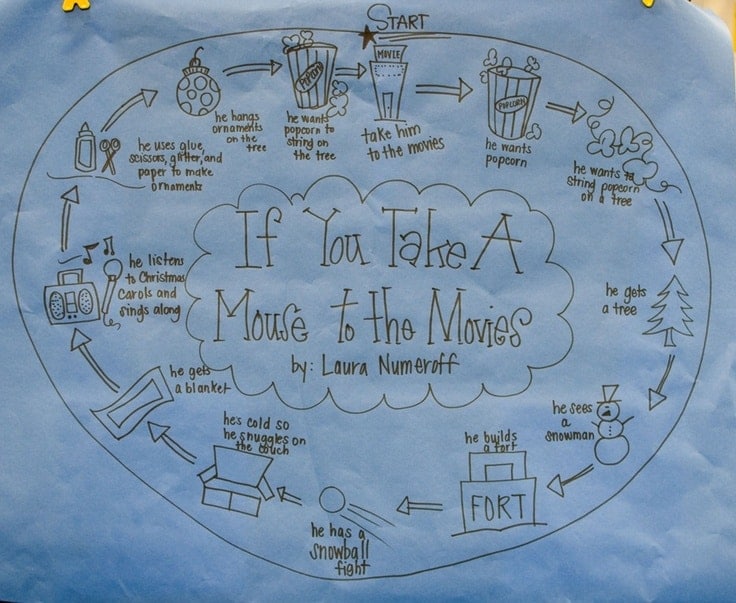
“High-tech”
This is a really easy-to-use website that allows the SLP or students to type in their own information based on the story events, in whatever language, and can be printed and sent to parents and teachers. www.readwritethink.org Here is an example of what we created:
- Max sent to his room: Max creates mischief and yells at his mother, so he is sent to his room without supper.
- Max’s room changes: Max’s room changes into a forest and he gets on a boat and crosses the ocean for almost a year.
- Max becomes king: Max gets to where the Wild Things live. They try to scare him, but he is brave. He becomes king of the Wild Things. They have a wild rumpus.
- Max gets lonely: After the rumpus, Max sends the Wild Things to bed without dinner. He starts to feel lonely and wants to go back home.
- Max leaves : The Wild Things do not want Max to leave, so he travels back home.
- Max arrives back at his bedroom: He finds his supper waiting for him. It is still hot.
Getting the best BANG for your BOOK:
What are the best parts of using Circular/Chain stories in therapy? By working on these macrostructure and story elements, we are automatically aligning to the core curriculum. We are also addressing multiple goals and are producing materials that can be used across several different disorder groups. Now THAT’s an effective and efficient way to do our jobs!
Great Books for Speech Therapy that use Circular Stories
So off you go! Below, you will also find a list of some of our other favorite Chain/Circular Stories that are written in both English and Spanish, along with a direct link to purchase it through Amazon. We hope you find this useful and would love to hear from you on how YOU use these books in therapy!
English |
Spanish |
Description of Story |
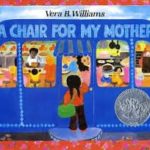 |
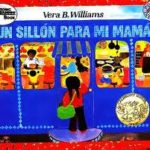 |
Plot: A family must work together with their community to rebuild their home after a fire. Why we like it: Plot, culture, great opportunities for visualizing and describing. |
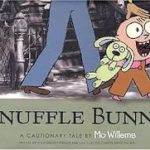 |
 |
Plot: On an errand to the laundromat, Trixie loses her beloved stuffed bunny and must figure out where he’s gone. Why we like it: Students identify with Trixie’s struggle to express herself. |
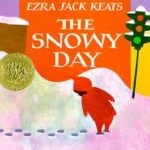 |
Un dia de nieve 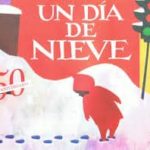 |
Plot: A little boy plays outside in the snow and then goes home to tell his mom all about it. Why we like it: Lots of opportunities for predicting, sequencing, and talking about the winter season. |
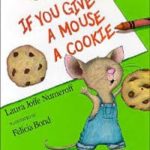
|
Si le das una galletita a un ratón 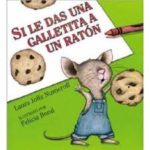 |
Plot: When a mouse invites himself into the house and is given a cookie, a number of entertaining consequences ensue. Why we like it: It’s a good way to introduce the concept of cause and effect and can be used for sequencing and predicting. |
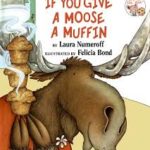 |
Si le das un panecillo a un alce 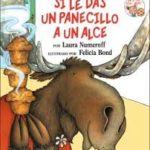 |
Plot: A surprise guest invites himself in and again takes advantage of a boy’s hospitality in an entertaining way. Why we like it: Similar to it’s predecessor, it’s also great for sequencing and making predictions, working on sentence building and vocabulary. |
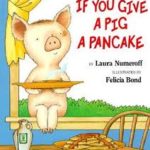 |
Si Le Das Un Panqueque a Una Cerdita 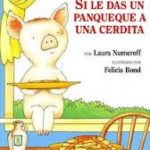 |
Plot: Following the similar structure of other circular stories by this author, a pig is given a pancake leading to a chain of consequences. Comical exploration concept, “If you give an inch, they’ll take a mile.” Why we like it: Similar to its predecessors, but with a female protagonist, it’s great for teaching cause and effect, predictions, and sequencing in a humorous light. |
|
Why Mosquitos Buzz in People’s Ears  |
Porque Zumban los Mosquitos en Los Oidos  |
Plot: A mosquito tells a lie to an iguana and sets off a series of events. It is a ‘fable-like’ story. Why we like it: It teaches the value of telling the truth, and is great for visualizing, describing, and sequencing. It provides a context to learn about different animals, cause and effect, and has beautiful illustrations. |
 |
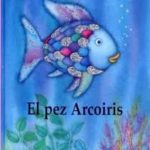 |
Plot: A proud fish learns a lesson about valuing inner beauty and friendship. Why we like it: Lovely illustrations, fairly predictable story that is good for vocabulary building, semantic mapping, and teaching predictions and inferencing. Great story for working on social/pragmatic skills (friendship building/initiating play). |
 |
 |
Plot: A Ukrainian story about a boy who loses a mitten knitted by his grandmother that many animals take refuge in to get out of the cold. Why we like it: Pre-school level story that is good for teaching animals and winter vocabulary. It is great for making predictions, and it is an easy story to teach basic story retell skills. |
 |
 |
Plot: A little boy imagines himself traveling to a far away place, where he makes unlikely friends and learns to appreciate what he has at home when he returns. Why we like it: Great story for inspiring children’s imaginations, wonderful book for working on consonant clusters in Spanish (/r/ clusters), vocabulary, talking about body parts, describing, and can be used with a wide range of ages. |
It is nice to see other speech pathologists invested in this idea. Here is another good post: Predictable Books Part I: Circular or Chain Stories


